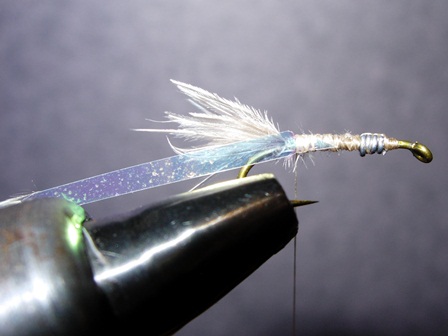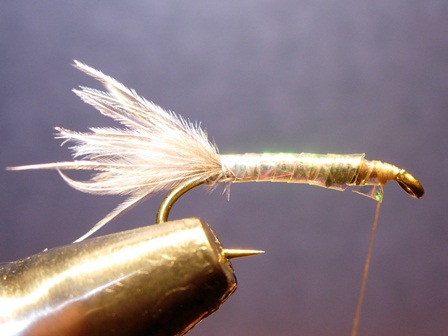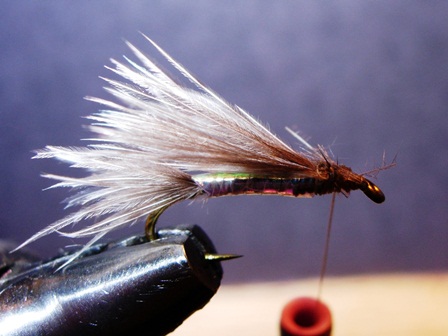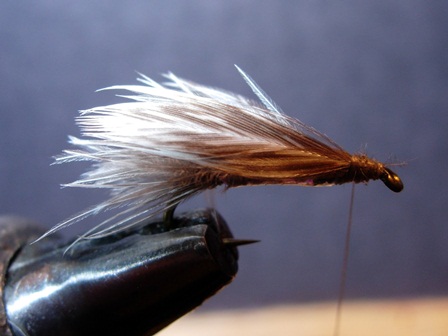Description
If you have not read Ralph Cutter's �Fish
Food,� you need to do that. This book is
clearly in the �must read� category for fly
fishers, whether experienced or not. One of
the phenomena that Ralph discusses in his
book is the egg-laying (sometimes called
�ovipositing�) habits of certain caddisfly
species. Unlike mayflies and stoneflies,
adults dive beneath the surface, crawl along
the bottom, lay their eggs, and then (if not
eaten by then) swim back to the surface and,
ultimately, once again become airborne.
Trout, of course, know this and anything
resembling a caddisfly that looks like it
is: (a) swimming down to the bottom; (b)
crawling along the bottom; or (c) swimming
to the surface, is fair game. There is much
more to this than I can include in this
short article, so reading Ralph'�s book is
essential if this phenomenon tickles your
curiosity.
The Flashy Chick Caddis is
my creation for all three of the stages
mentioned above. The �flashy� part of the
name comes from the fact that the body is
fashioned of mylar tinsel. The �chick� part
of the name is derived from the material
used for the rest of the fly: chicken
marabou, or �chickabou� as it is sometimes
called. Chickabou feathers are found at the
bottom of a hen cape (see picture). Some hen
capes come without the chickabou patch, so
examine each cape to make sure that is not
the case before you buy one. I have also
seen chickabou feathers separately packaged.
There are only three materials needed for
this fly, other than the hook: a spool of
mylar tinsel (medium size is good);
chickabou feathers; and a hen hackle. Some
of the tying steps are from a pattern called
the Tabou Caddis, which you will find at
http://globalflyfisher.com/patterns/taboucaddis/
Ah, blessed simplicity. Life is good.
Tying Instructions
|
|
1.
Smash the hook barb. Wrap 3 turns of weight
at the thorax area, which will be about 2
eye-widths behind the hook eye.
2.
Cover the shank with thread, leaving it at
the back of the barb.
3.
Tie in a tail made of chickabou at a point
on the shank that is just above the back of
the barb. The tail should be about shank
length.
4.
Cut a piece of mylar tinsel from the spool
and tie it in just above the back of the
barb.
|

|
|
|
|
4a.
Move the thread to the hook eye.
Wind the mylar forward to the hook
eye and tie it off there.
|

|
|
|
|
-
Tie in a chickabou underwing at a point
about 1/3 shank length behind the eye (it's
OK to wrap backwards over the mylar). The
underwing should extend to the bend of the
hook.
|

|
|
|
|
|
-
Pluck a feather from a hen cape, pull off
all of the fuzz, and measure it so it is the
same length as the underwing. Lay it flat,
concave side down, on the hook shank and tie
it in at the same place as the underwing was
tied in. Make sure it stays flat as you tie
it down.
|

|
|
|
|
|
-
Pull the wing case over the top of
the thorax, tie it down in front of
the thorax, and trim the excess.
Tie in a chicabou feather by its tip, just
in front of the wing base. Wrap it a couple
of times around the shank and tie it off
behind the eye. Moisten your fingers, sweep
the barbules back, form a nice small head,
and whip finish.
|

|
|
Tie one of these gems to the end of your
tippet and fish it like you would a wet fly
(i.e., swing it). Alternately, tie it as a
stinger to the bend of the bottom fly on a
short line rig; then do a short line drift,
but let it swing into a wet fly swing, and�
 |
|
